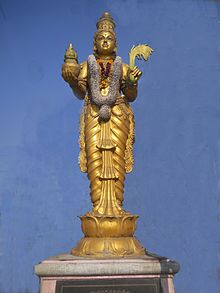మలేషియా తెలుగువారు | |
|---|---|
 Telugu Talli, the personification of the Telugu people and culture | |
| Total population | |
| 126,000–300,000[1] | |
| Regions with significant populations | |
| Languages | |
| Telugu, Bahasa Malaysia and English | |
| Religion | |
| Hinduism | |
| Related ethnic groups | |
| Malaysian Indians, Telugu people |
Malaysian Telugus (Telugu: మలేషియా తెలుగువారు, romanized: Malēṣiyā Teluguvāru; Malay: Orang Telugu Malaysia), consist of people of full or partial Telugu descent who were born in or immigrated to Malaysia. Most Malaysian Telugus are descended from migrants from Madras Presidency during the colonial period. Historically, most Malaysian Telugus originated from the Uttarandhra region with some from the East Godavari and Chittoor regions of present-day Andhra Pradesh.[1]
The current population of Malaysian Telugus are mostly third and fourth generation Telugus who descended from indentured laborers under the Kangani system who arrived in the 19th and early 20th century.[2][3] While most Telugus came to Malaysia as crop labourers, some were professionals and traders who arrived as refugees. For example, in the 1930s following anti-Indian riots, and during World War II when the Japanese invaded, some ethnic Telugus fled from Burma to Malaya.[4] More recently the Telugu language and culture have been resurgent.[5]
- ^ a b Satyanarayana, Adapa (2008). "Telugu Diaspora in South East/West Asia, 1871-1990". Proceedings of the Indian History Congress. 69. Indian History Congress: 904–914. JSTOR 44147252.
- ^ Cite error: The named reference
:0was invoked but never defined (see the help page). - ^ Cite error: The named reference
The Hinduwas invoked but never defined (see the help page). - ^ Morhan, Sivanisvarry (20 February 2024). "Documenting, preserving Malaysian Telugu heritage". The Sun. Retrieved 6 August 2024.
- ^ Cite error: The named reference
Ram Anandwas invoked but never defined (see the help page).